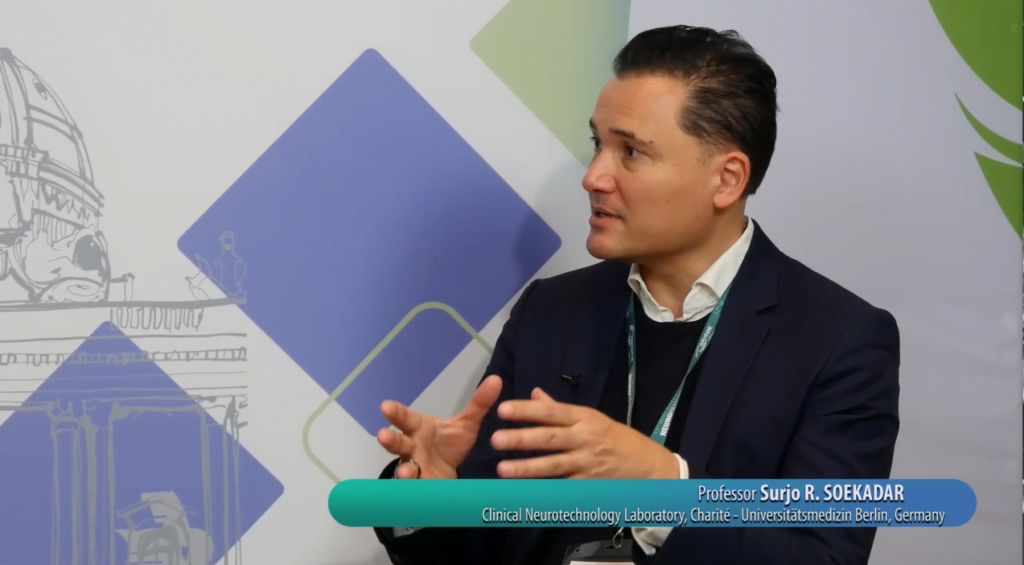Adapted Interview with Prof. Surjo R. Soekadar – World Congress for Neurorehabilitation (WCNR) Vienna 2022

Interviewer: Ștefana-Andrada Dobran
Interviewee: Professor Surjo R. Soekadar
Professor Surjo R. Soekadar studied medicine in Mainz, Heidelberg, and Baltimore and graduated with a doctorate in clinical neuropsychology. From 2005 to 2018, he worked as a physician at the University of Tübingen, where he became head of the Applied Neurotechnology Lab in 2011. In 2018, he was appointed Germany’s first Professor of Clinical Neurotechnology at the Charité – Universitätsmedizin Berlin. The professorship is supported by the Einstein Foundation Berlin.
Together with his team at the Clinical Neurotechnology Laboratory, Professor Soekadar investigates how neuro-technologies can be used in the treatment of neurological and psychiatric disorders. The laboratory develops and applies novel brain-computer and machine interfaces (BCI/BMI) to translate brain activity into control commands of external devices and their combination with non-invasive brain stimulation.
For news regarding the EFNR’s activity, visit:
S.A.D.: Hello, dear Professor Soekadar! We are here, in Vienna, for the 12th World Congress for NeuroRehabilitation, organised by the World Federation for NeuroRehabilitation. What is your first-hand opinion of the event, and have you participated in any previous editions?
S.R.S.: I greatly enjoy being here so far. I think it is a fantastic opportunity to learn about research and to connect to other people that we could not meet personally due to the pandemic. In the last event, I could, therefore, only meet people online. So that was my previous experience, and now, things are completely different. While there are some advantages of meeting online, obviously, for example, you don’t have to travel, I think it is a worthwhile ‘sacrifice’ because you can directly engage with the people and well, there are also so many opportunities to discuss. When you are in front of your computer all the time, it is a different thing. I greatly enjoyed the congress, and I think it is an invaluable resource to reconnect after the pandemic.
S.A.D.: What do you believe is the overarching theme of this year’s event?
S.R.S.: That is a very good question! I think the goal of WCNR is really to have a multidisciplinary platform to learn about new ideas, new concepts for neurorehabilitation from different perspectives. I think neuro-technology, of course, was a very important aspect, and also other technologies that one would probably not learn about by just surfing the internet. Here, you can really experience these new technologies firsthand. You see so many demonstrations. That is something that I took as a great advantage in visiting this congress.
S.A.D.: From your perspective, what is the role of hybrid multidisciplinary events in developing neurorehabilitation research and practice, and which similar avenues are worth exploring?
S.R.S.: I think this congress is really a key institution in the field of neurorehabilitation because it combines so many aspects. One is the multidisciplinary environment, and the other one is that it is international. So you really get perspectives from other countries and how they tackle problems. Sometimes it helps you to re-evaluate your own situation and think about new solutions.
I believe it is a great event that I would never want to miss.
S.A.D.: What are some avenues for brain or neural interfaces in increasing the quality of life for the patients?
S.R.S.: There are a number of effective treatment strategies for patients who have some remaining functions that you can build on and train. But there is always a share of patients who have no remaining functionalities, like complete finger paralysis or complete paralysis. The brain/neural-computer interfaces, they deliver a new tool that can help you to restore function where there was no function. And since we have seen that we can use these brain-computer interfaces (BCIs) also to restore motor function, we can build on this first step and then improve function over a pipeline of different approaches that we personalize.
S.A.D.: What functions of the brain require the most complex strategies for restoration?
S.R.S.: I think the biggest challenge is to generalise. What happens is that we try to restore a function in a certain context. And we have to do it because otherwise, it becomes too complex. We have to constrain the context and focus on a certain function, but really to scale up and generalise, we need to bridge that into daily life. And that is a big challenge. I think that any function that can be generalised into daily life is already complex. We know this from all the different domains of neurorehabilitation, but the key here is really generalisation into daily life. I think that so many things have been developed in the last years to address this issue, to go from out-patient into home-based rehabilitation, and also to foster this with digital tools that now, these are really exciting times for the field of neurorehabilitation.
There are so many new tools due to digitalization – advances in 3D printing, brain-computer interface, and so on.
S.A.D.: Thank you for the interview!
S.R.S.: Thank you!
We kindly invite you to browse our Interview category: https://efnr.org/category/interviews/
For sure you will find a cluster of informative discussions with different specialists in the field of neurorehabilitation.









